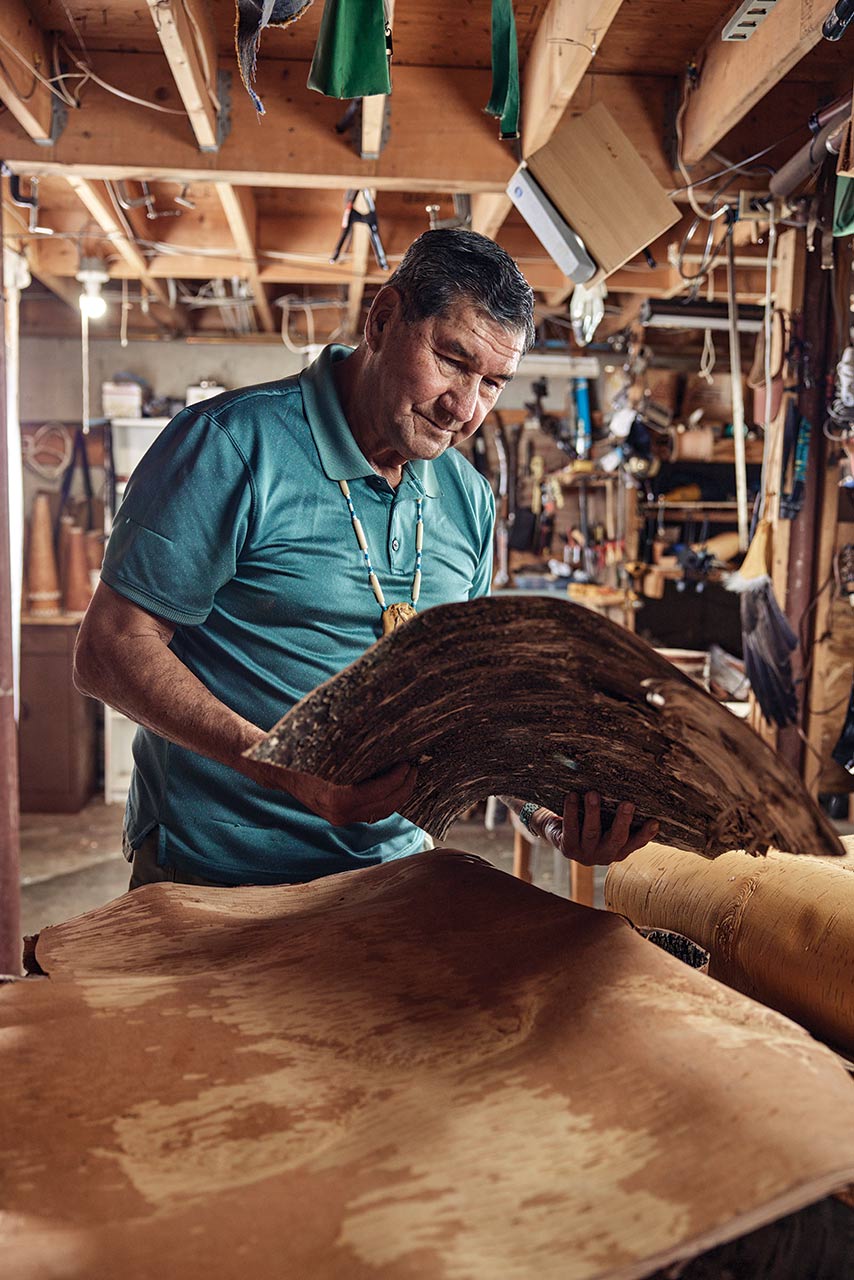By Jaed Coffin
Photos by Michael D. Wilson
From our November 2022 issue
Not all bark is created equal, 82-year-old Butch Phillips says, and he should know. For more than 30 years, Phillips, a member of the Penobscot Nation who grew up on Indian Island, has been making birch-bark moose calls in his basement workshop, in neighboring Milford. Wabanaki hunters have long used moose calls to lure their quarry. Phillips constructs his horn-shaped, 18-inch-long calls from bark that he harvests from tribal land. For unadorned — or “plain” — calls, he uses golden-hued summer bark, which lacks the inner “rind” essential for etching. In late spring and early fall, he collects leatherier winter bark, stripping it from the tree with the dark rind intact. After a process of wetting, bending, shaping, and stitching, he begins the artistic phase: hours of carving into the rind to reveal its white underside. “Some bark is thick, some is thin. Some is stiff, some is supple,” Phillips says. “Some is good for etching, and some is not.”
Butch Phillips bases many of his designs off Wabanaki carvings and beadwork.
He never etches with a specific vision in mind. “I just start, and it evolves,” he says. And though no two calls are ever the same, certain aesthetic principles unify his work, beginning always with the “double-curve” — a uniquely Wabanaki motif that some believe is modeled on the contours of a fiddlehead. He also prefers compositional balance, etching the same figures on both sides of a call — a moose head, a profile of Katahdin, a hummingbird, or one customer’s prized beagles. Long hours go into each one. “I’ve got to be thinking all the time,” Phillips says. “Once you scrape away that brown, it’s gone forever, and it’s pretty hard to cover up mistakes.” During these periods of artistic focus, Phillips lets himself become completely enveloped in his craft. “I just go somewhere else,” he says.
Tell Us More
Butch Phillips
Where do you get your inspiration?
I try to honor my ancestors — everything my ancestors had or did. In our prayers and ceremonies, we always pay tribute to Mother Earth. I always pay tribute to plants and animals because they’ve kept us alive since time immemorial. I incorporate them into my etchings. Some designs are not mine. My ancestors thought them up. I just keep them alive.
How does a moose call work?
It’s a megaphone — you make the noise with your mouth in the small end, and the horn amplifies it. I usually use a cow call. If the moose smells me, I might switch to a grunt and scrape it against a tree, so they think it’s a bull. They come in thinking they’re defending territory. When they get close, I might put the call down to the ground, muffle it, and point it away, so it sounds like I’m farther away. I want the moose to step into a clearing. I’ve shot them from 10 paces away.


What’s the market for these like?
I’ve given a pile of them away, especially to our hunters. I donate a lot to fundraisers. Early on, I went to a basket show with 25 calls and sold out. Back then, I didn’t sell them for much, $35 to $45. Now, a basic call with nothing on it sells for $100. Once I start putting artwork on it, that’s what makes a call expensive. Now, I’ve sold hundreds. Some with designs go for $800. One at an Abbe Museum auction went for $3,200. I’m selling them as fast as I can make them.
How do you get so much detail in your work?
I sometimes use X-Acto knives, but I prefer my small pocket knife, which my late wife, Linda, gave to me. I fell head over heels in love with her in the second grade. It’s not a traditional tool, but, you know, my wife bought it for me.








